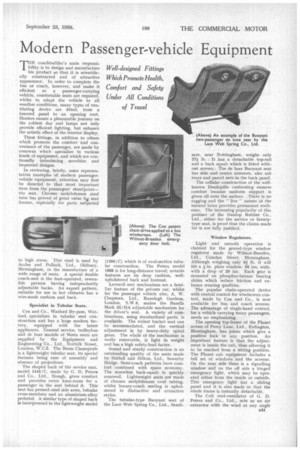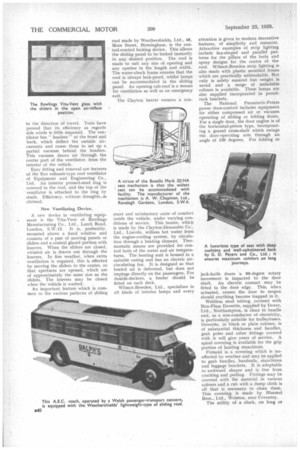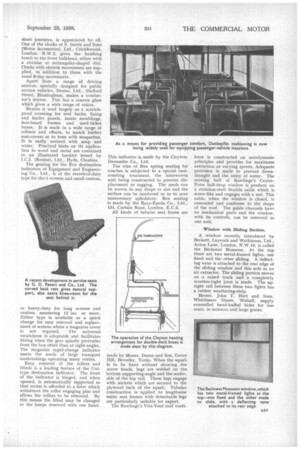Modern Passenger-vehicle Equipment
Page 75

Page 76

Page 77

If you've noticed an error in this article please click here to report it so we can fix it.
Well-designed Fillings Which Promote Health, Comfort and Safety Under All Conditions of Travel
"THE coachbuilder's main responsi
bility is to design and manufacture his product so that it is scientifically constructed and of attractive appearance. In order to complete the bus or coach, however, and make it efficient as a passenger-carrying vehicle, comfortable seats are required. whilst to adapt the vehicle to all weather conditions, many types of ventilating device are fitted, from a louvred panel to an opening roof. Heaters ensure a pleasurable journey on the coldest day and lamps not only provide efficient lighting, but enhance the artistic effect of the interior display.
These fittings, in addition to others which promote the comfort and convenience of the passenger, are made by concerns which specialize in various kinds of equipment, and which are continually introducing novelties and improved designs. .
In reviewing, briefly, some representative examples of modern passengervehicle equipment, attention may first be directed to that most important item from the passengers' standpoint— the seat. Chrome molybdenum steel tube has proved of great value fri seat frames, especially for parts subjected
to high stress. This steel is used by Accles and Pollock, Ltd., Oldbury, Birmingham, in the manufacture of a wide range of seats. A special double coach-seat is the foot-operated, reversible pattern having independently adjustable backs. An export pattern, suitable for use in hot climates has a wire-mesh cushion and back.
Specialist in Tubular Seats.
Cox and Co., Watford By-pass, Watford, specializes in tubular seat construction and has a large modern factory, equipped with the latest appliances. General service, trolleybus and de luxe models of Nesta seats are supplied by the Equipment and Engineering Co., Ltd., Norfolk Street, London, W.C.2. The Ne,sta Claineprufe is a lightweight tubular seat, its special features being ease of assembly and absence ef projections.
The shaped back of the service seat. model 1445/C, made by G. D. Peters and Co., Ltd., Slough, gives comfort and provides extra knee-room for a passenger in the seat behind it. This seat has pressed-steel side arms, tubular cross-members and an aluminium-alloy pedestal. A similar type of shaped back is incorporated in the lightweight model
(1300/C) which is of oval-section tubular construction. The Peters model 1888 is for long-distance travel; notable features are its deep cushion, wellupholstered back and footrest.
Leveroll seat mechanisms are a familiar feature of the private car, whilst for the passenger vehicle also, A. W. Chapman, Ltd., Ranelagh Gardens, London, S.W,6, makes the Busella Mark 32/HA adjustable mechanism for the driver's seat. A variety of combinations, using standardized parts, is available. The widest bucket seat can be accommodated, and the vertical adjustment is by heavy-duty spiral gears. The whole of the mechanism is easily removable, is light in weight and has a high safety-load factor.
Sound and sturdy construction is an outstanding quality of the seats made by Siddall and Hilton, Ltd., Sowerby Bridge. Semi-coach patterns have comfort combined with space economy. The screwless back-squab is quickly removed. Lightweight seats are made of chrome molybdenum oval tubing, whilst luxury-coach seating is upholstered in distinctive and attractive styles.
The tubular-type Buoyant seat of the Lace Web Spring Co., Ltd., Sandi
acre, near Nottingham, weighs only 271 lb. It has a detachable top-rail and a back squab which is fitted without screws. The de luxe Buoyant seat has side and centre armrests, also ash trays and parcel nets in the back panel.
The cellular construction of the wellknown Dunlopillo cushioning ensures comfort because uniform support is given all over the surface. There is no sagging and the " live " nature of the natural latex provides permanent resilience. The increasing popularity of this product of the Dunlop Rubber Co., Ltd., either for the service or luxurytype seat, is proof that the claims made for it are fully justified.
Window Regulators.
Light and smooth operation is claimed for the geared-type window regulator made by Wilmot-Breeden, Ltd., Camden Street, Birmingham. Although weighing only 61 lb. it will lift a 1-in, plate window, 56 ins, wide, with a drop of 20 ins. Each gear is mounted on phosphor-bronze bearing shims which reduce friction and enhance wearing qualities.
The popular chain-operated device with central control for windscreen control, made by Cox and Co., is now available for bus and coach screens. The advantage of single-hand control, for a vehicle carrying many passengers, needs no emphasizing.
The opening top-frame of the Planet screen of Percy Lane, Ltd., Erdington, Birmingham, has joints which give a positive lock in any position. An important feature is that the adjustment is inside the cab, thus allowing it to be reached from a sitting position. The Planet cab equipment includes a full set of windows and the screens. On the near side there is a signalling window and on the off side a hinged emergency light, which may be operated either from the inside or outside. This emergency light has a sliding panel and it is also made so that the whole frame is instantly detachable.
The Colt roof-ventilator of G. D. Peters and Co., Ltd., acts as an air extractor with the wind at any angle to the direction of travel. Tests have proved that its efficiency as regards side winds is little impaired. The ventilator has " headers " at the front and back, which deflect the outside aircurrents and cause them to set up a partial vacuum behind the headers. This vacuum draws air through the centre port of the ventilator, from the interior of the vehicle.
Easy fitting and removal are features of the Ea) exhaust-type roof ventilator of Equipment and Engineering Co., Ltd. An interior pressed-steel ring is screwed to the roof, and the top of the ventilator is attached to the ring by studs. Efficiency, without draughts,_is claimed.
New Ventilating Device.
A new device in ventilating equip . ment is the Vita-Vent of Rawlings Manufacturing Co., Ltd., Larch Road, London, S.W.12. It is, preferably. mounted above a fixed window and consists of a pair of moving panels or sliders and a central glazed portion with louvres. When the sliders are closed, vitiated air is drawn out through the louvres. In fine weather, when extra ventilation is required, this is effected by moving the sliders to the centre, so that apertures are opened, which are of approximately the same size as the sliders. The louvres may be closed when the vehicle is washed.
An important feature which is common to the various patterns of sliding roof made by Weathershields, Ltd., 48, Moor Street, Birmingham, is the central-control locking device. This allows the sliding panel to be locked instantly in any desired position. The roof is made to suit any size of opening and any camber in the length and width. The water-check frame ensures that the roof is always leak-proof, whilst lamps can be accommodated in the sliding panel. An opening cab-roof is a means for ventilation as well as an emergency exit.
The Clayton heater ensures a con stant and satisfactory state of comfort inside the vehicle, under varying conditions of service. This heater, which is made by the Clayton-Dewandre Co., Ltd., Lincoln, utilizes hot water from the engine-cooling system, by circulation through a heating element. Thermostatic means are provided for control both of the water and air temperatures. The heating unit is housed in a suitable casing and has an electric aircirculating fan. It is designed so that heated air is delivered, but does not impinge directly on the passengers. For double-deckers, a heater should be fitted on each deck, Wilmot-Breeden, Ltd., specializes in all kinds of interior lamps and every attention is given to modern decorative features, of simplicity and restraint. Attractive examples of strip lighting include fan-shaped and parallel patterns for the pillars of the body and spray designs for the centre of the roof. Wilmot-Breeden strip lighting is also made with plastic moulded lenses which are practically unbreakable. Not only is safety ensured but weight is saved and a range of unfadable colours is available. These lamps are also supplied incorporated in parcelrack brackets.
The National Pneumatic-Peters power door-control includes equipment for either compressed air or vacuum operating of sliding or folding doors. For a single door, the door engine is of the horizontal-piston type, incorporating a geared cross-shaft which swings the door-operating arm through an angle of 120 degrees. For folding or jack-knife doors a 90-degree rotary movement is imparted to the door shaft. An electric contact may be fitted in the door edge. This, when actuated, causes the door to reopen should anything become trapped in it.
Weldless steel tubing, covered with Non-Flam Doverite, supplied by Dover, Ltd., Northampton, is clean to handle and, as a non-conductor of electricity, is particularly suitable for trolleybuses. Doverite, in black or plain colours, is of substantial thickness and handles, grab poles and other fittings covered with it will give years of service. A. spiral covering is available for the grip portion of landing stanchions.
Firmoid is a covering which is unaffected by weather and may be applied to grab handles, handrails, stanchions and luggage brackets. It is adaptable to awkward shapes and is free from cracking and peeling. Fittings may be covered with the material in various colours and a rub with a damp cloth is all that is necessary to clean them. This covering is made by Bluemel Bros„ Ltd., Wolston, near Coventry.
The utility of a clock, on long or short journeys, is appreciated by all. One of the clocks of S. Smith and Sons (Motor Accessories), Ltd., Cricklewood, London, N.W.2, gives the finishing touch to the front bulkhead, either with a circular or rectangular-shaped dial. Clocks with electric movements are supplied, in addition to those with the usual 8-clay movements.
Apart from a range of driving mirrors, specially designed for public service vehicles, Desmo, Ltd., Stafford Street, Birmingham, makes a conductor's mirror. This has a convex glass which gives a wide range of vision.
Rexine is used largely as a scratchproof covering for seat backs, lining and fender panels, inside mouldings, fare-board frames and used-ticket boxes. It is made in a wide range of colours and effects, to match leather seat-covers or to tone with moquettes. It is easily revived with soap and water. Practical hints on its application to wood and metal are contained in an illustrated booklet issued by I.C.I. (Rexine), Ltd., Hyde, Cheshire.
The gearing for the Eco destination indicators of Equipment and Engineering Co., Ltd., is of the standard-duty type for short screens and small centres.
or heavy-duty for long screens and centres, measuring 12 ins, or more. Either type is available as a quick change for easy removal and replacement of screens where a magazine cover is not required. The universal escutcheon is adaptable and facilitates fitting when the gear spindle protrudes from the box other than at right-angles. The magazine rapid-change indicator meets the needs of large transport undertakings operating many routes.
Easy removal of the rollers and blinds is a leading feature of the Unitype destination indicator. The front of the indicator is hinged, and when opened, is automatically supported so that access is afforded to a lever which withdraws the roller engaging pins and allows the rollers to be removed. By this means the blind may be changed or the lamps renewed with one hand. This indicator is made by the ClaytonDewandre Co., Ltd.
The wire of Rex spring seating for coaches is subjected to a special rustresisting treatment, the interwoven unit being constructed to prevent displacement or sagging. The mesh can be woven to any shape or size and the surface can be cambered so as to save unnecessary upholstery. Rex seating is made by the Raco-Epeda Co., Ltd., 131, Curtain Road, London, E.C.2.
All kinds of tubular seat frame are
made by Messrs. Deans and Son, Grove Hill, Beverley, Yorks. When the squab is to be fixed without showing the screw heads, lugs are welded on the bottom supporting-angle and the underside of the top rail. These lugs engage with sockets which are secured to the plywood back of the squab. Tubular construction is applied to lengthwise seats; seat frames with detachable legs are particularly suitable for export.
The Rawlings's Vita-Vent roof venti
lator is constructed on aerodynamic principles and provides for maximum extraction at varying speeds. Adequate provision is made to prevent downdraught and the entry of water. The moving half of Rawlings's CentrePoise half-drop window is pendant on a stainless-steel flexible cable which is screw-like and engages with a nut. This cable, when the window is closed, is concealed and conforms to the shape of the roof. The guide channels have no mechanical parts and the window, with its controls, can be removed as one unit.
Window with Sliding Section.
A window recently introduced by Beckett, Laycock and Watkinson, Ltd., Acton Lane, London, N.W.10, is called the Beelawat Monsoon. At the top there are two metal-framed lights, one fixed and the other sliding. A deflecting vane is attached to the rear edge of the sliding window and this acts as an air extractor. The sliding portion moves on a raised track and a completely weather-tight joint is made. The upright rail between these two lights has a rubber weathering-strip.
Messrs. John T. Hart and Sons, Whittimere Street, Walsall, supply enamelled hand-buffed hides for bus seats, in morocco and large grains.












































































































































